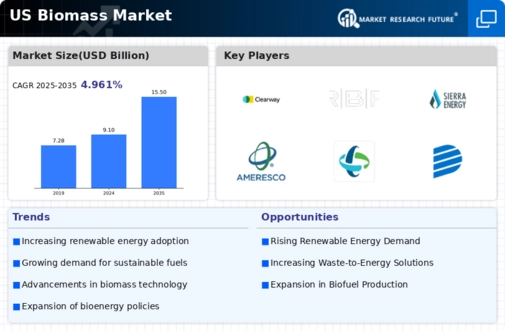The biomass market in the United States is characterized by a dynamic competitive landscape, driven by increasing demand for renewable energy sources and a growing emphasis on sustainability. Key players such as Enviva Holdings (US), Drax Group (GB), and BioEnergy DevCo (US) are strategically positioning themselves to capitalize on these trends. Enviva Holdings (US) focuses on expanding its production capacity and enhancing its supply chain efficiency, while Drax Group (GB) emphasizes innovation in biomass technology and sustainable sourcing. BioEnergy DevCo (US) is actively pursuing partnerships to bolster its operational capabilities, thereby shaping a competitive environment that is increasingly focused on sustainability and technological advancement.
The business tactics employed by these companies include localizing manufacturing and optimizing supply chains to enhance operational efficiency. The market structure appears moderately fragmented, with several players vying for market share. However, the collective influence of major companies is significant, as they drive innovation and set industry standards, thereby shaping the overall competitive dynamics.
In November 2025, Enviva Holdings (US) announced the opening of a new production facility in North Carolina, aimed at increasing its output of wood pellets. This strategic move is likely to enhance its market position by meeting the rising demand for biomass fuel, particularly in the European market, where stringent emissions regulations are driving a shift towards renewable energy sources. The facility is expected to create numerous jobs and contribute to local economies, further solidifying Enviva's commitment to sustainable practices.
In October 2025, Drax Group (GB) unveiled a new initiative to invest in advanced biomass technology, focusing on carbon capture and storage (CCS) solutions. This initiative is significant as it positions Drax as a leader in the integration of innovative technologies within the biomass sector, potentially reducing the carbon footprint of biomass energy production. By investing in CCS, Drax aims to enhance its sustainability credentials and appeal to environmentally conscious consumers and investors alike.
In September 2025, BioEnergy DevCo (US) entered into a strategic partnership with a leading agricultural firm to develop biomass feedstock from agricultural waste. This collaboration is crucial as it not only diversifies BioEnergy's feedstock sources but also promotes circular economy principles by utilizing waste materials. Such partnerships are indicative of a broader trend towards sustainability and resource efficiency within the biomass market.
As of December 2025, current competitive trends in the biomass market are increasingly defined by digitalization, sustainability, and the integration of advanced technologies such as AI. Strategic alliances among key players are shaping the landscape, fostering innovation and enhancing operational efficiencies. The competitive differentiation is likely to evolve from traditional price-based competition to a focus on innovation, technology, and supply chain reliability, as companies seek to meet the growing demand for sustainable energy solutions.
























Leave a Comment